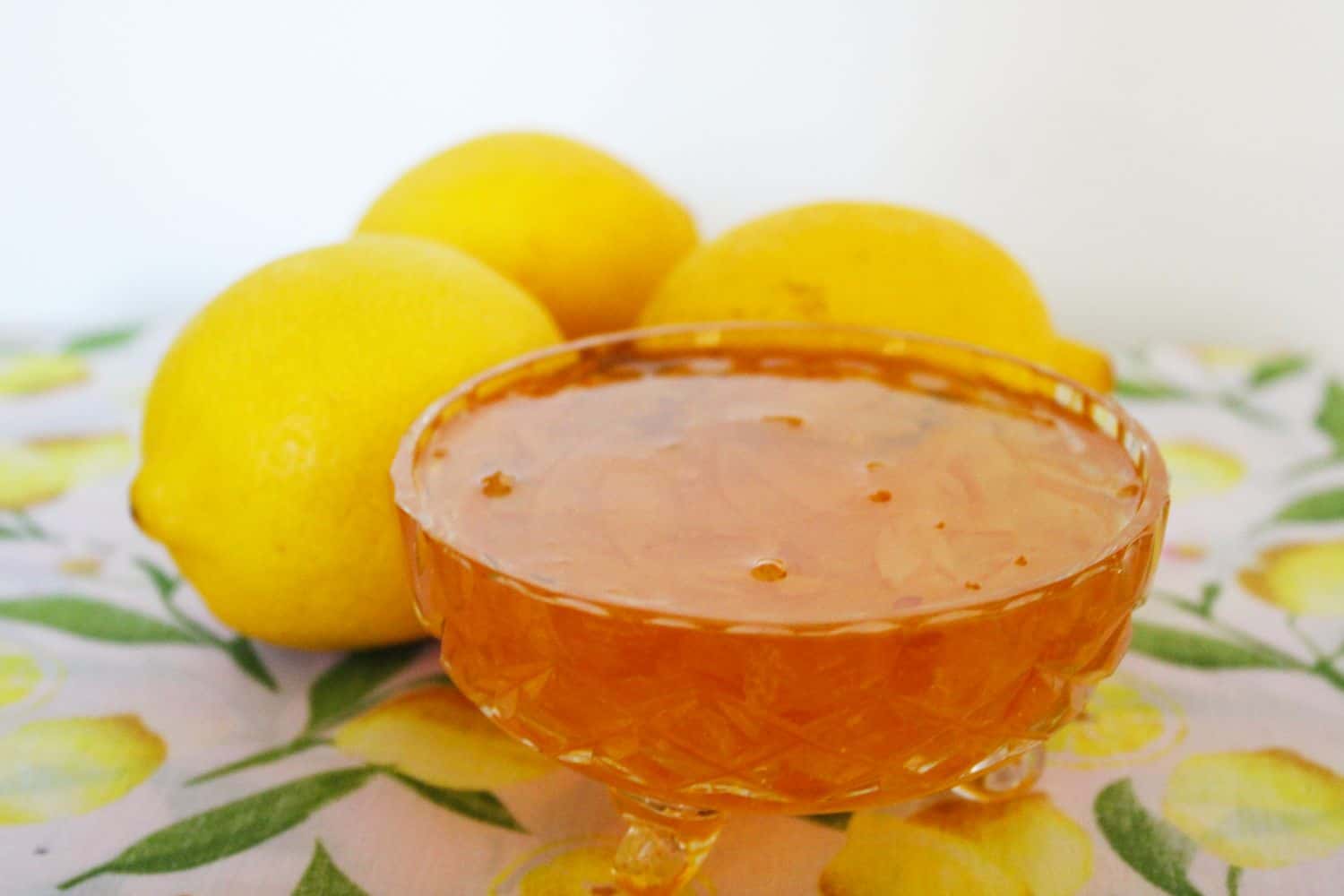
Lemon Marmalade has always been a favourite with my parents, my father in particular. He has been without his homemade breakfast condiment for a few weeks now and has politely let us know that a jar of shop-bought marmalade is not on his agenda.
As fortune would have it, a friend presented me with some beautiful, homegrown lemons and I have set to work. This is a classic method of making marmalade. It requires just three ingredients, and one of them is water. That is all that you need to make this fresh-flavoured condiment.
If you think that making marmalade is difficult, I want to assure you that it is easier than you may think. Although there is a great deal of science involved, it just requires that you follow a few simple steps.
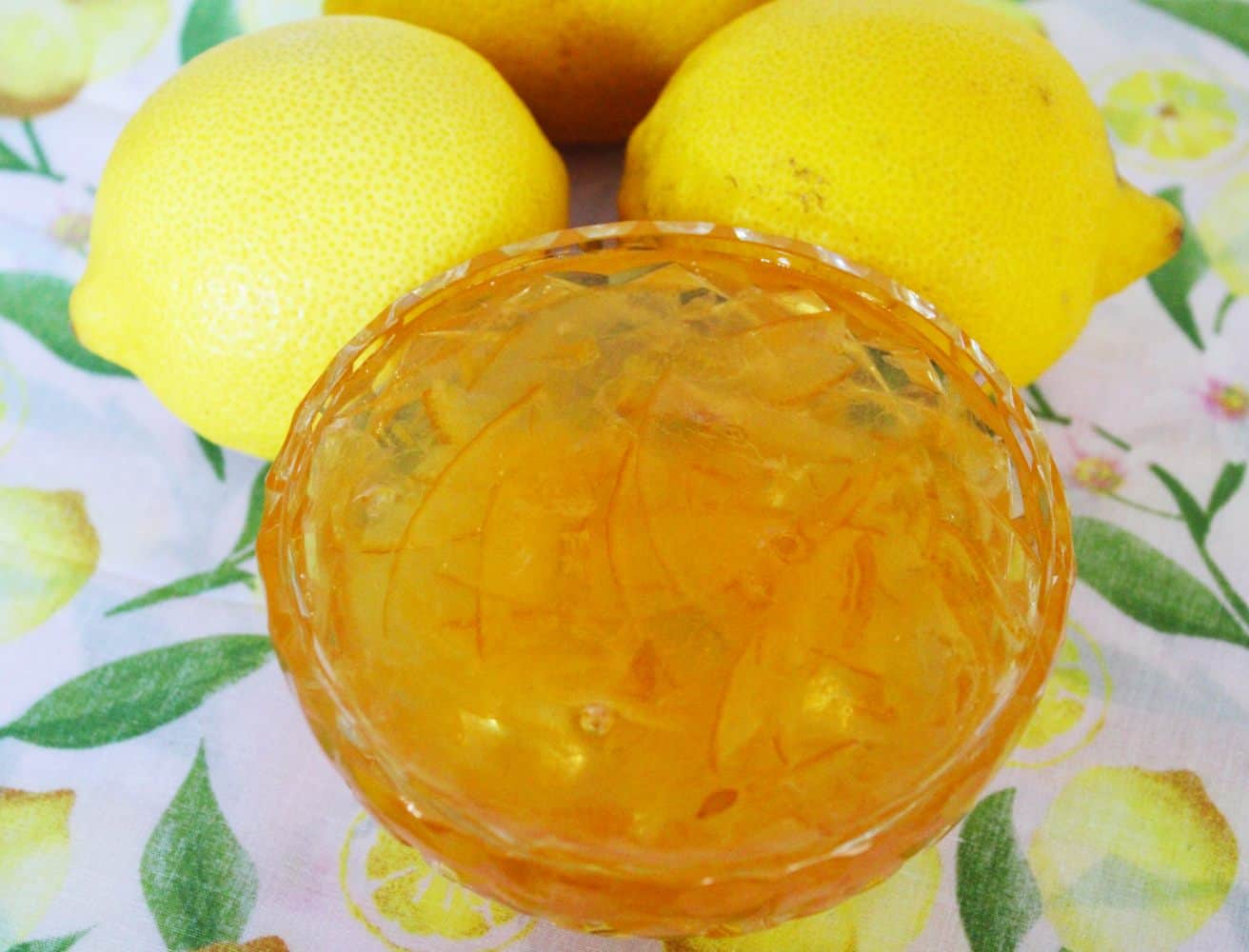
Let me tell you a little about Marmalade:
Marmalade is a favoured preserve on many breakfast tables. It’s easy to appreciate that this zesty, tangy preserve is a great way to start the day.
Marmalade is only made from citrus fruits, unlike jam, which can be made from any variety of fruit. Moreover, citrus fruits are rich in naturally occurring pectin. High amounts of pectin and acid, such as in citrus, help the marmalade to set, making it ideal for preserving. As such, it is not necessary to buy special jam-setting sugar.
I regard homemade jams and spreads as luxury items. It’s not that they are expensive to make, especially when the fruit is a gift, but there is an investment of time. However, having jars of marmalade that you have made yourself is tremendously satisfying.
The flavours are bright and clear and remember, there are just three ingredients. Compare that with the labels of some commercial varieties which often have a large range of additives.
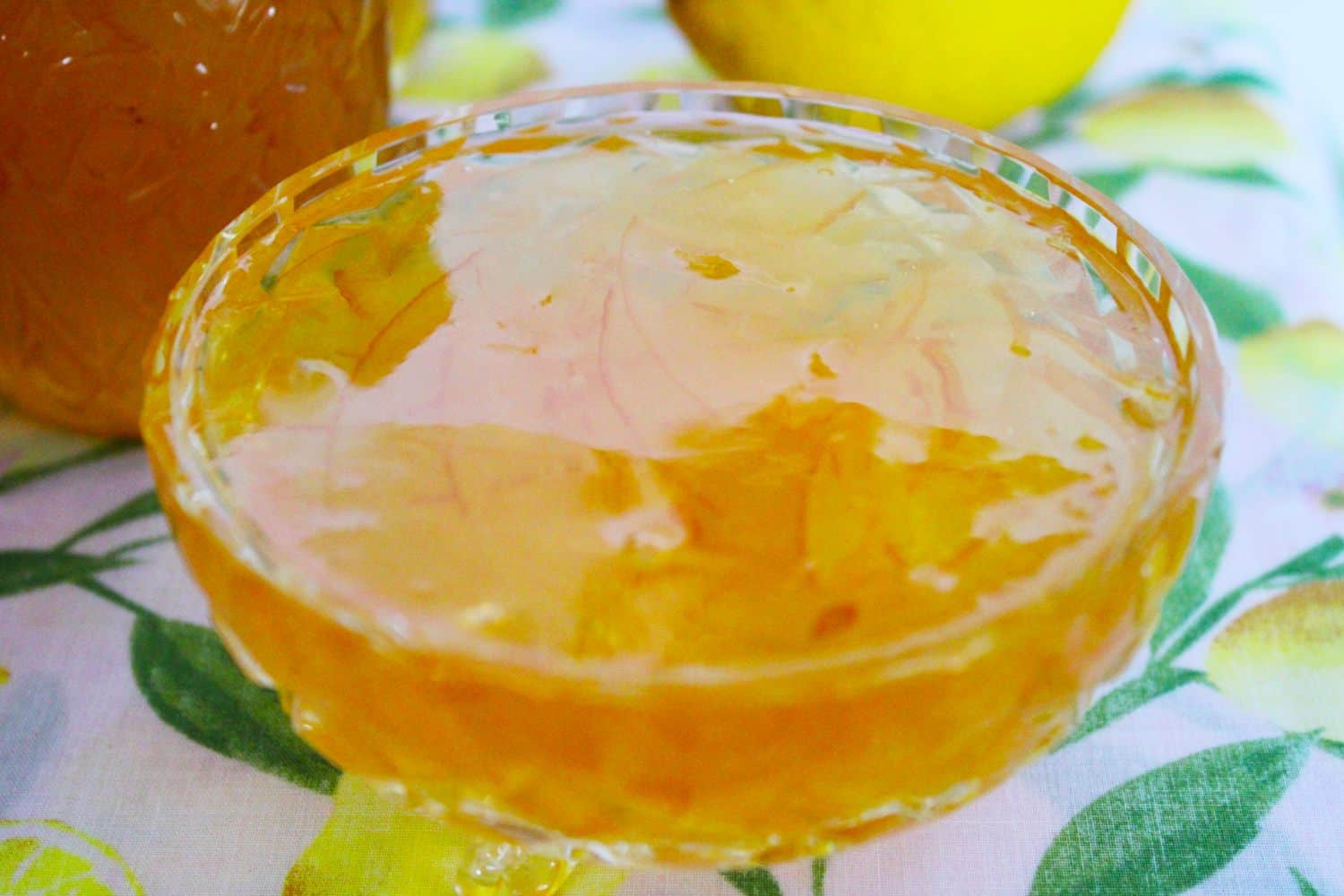
Ingredients in my Three Ingredient Lemon Marmalade:
Lemons:
Given that we will be using the entire fruit, it is preferable to use home-grown or organic lemons. Commercially produced lemons generally have a wax coating and may have been sprayed.
Sugar:
I use regular, granulated sugar. It is a large amount of sugar but it does much more than sweeten the marmalade. Its main function is to combine with the pectin and fruit acids to form a gel. In addition, it acts as a preservative that inhibits the growth of mould.
I don’t recommend reducing the amount of sugar as it may interfere with the setting and preservation.
Water:
I have used filtered water but regular tap water is also fine.
How to make Three Ingredient Lemon Marmalade:
Making the marmalade is a two-day process. On the first day, you slice the lemons very finely and put them into a large bowl with water to soak overnight. Soaking the fruit serves two purposes.
Firstly, it softens the peel and secondly, it helps release the pectin required for setting the jam. On day two you cook the fruit and add the sugar.
When setting point is reached, as outlined in the recipe instructions, I remove the saucepan from the heat and set it aside for 10 minutes. This will help the fruit to settle and evenly distribute when poured into the jars.
Without settling, the fruit will rise to the top of the marmalade. And finally, ladle it into jars and smile with satisfaction at the result.
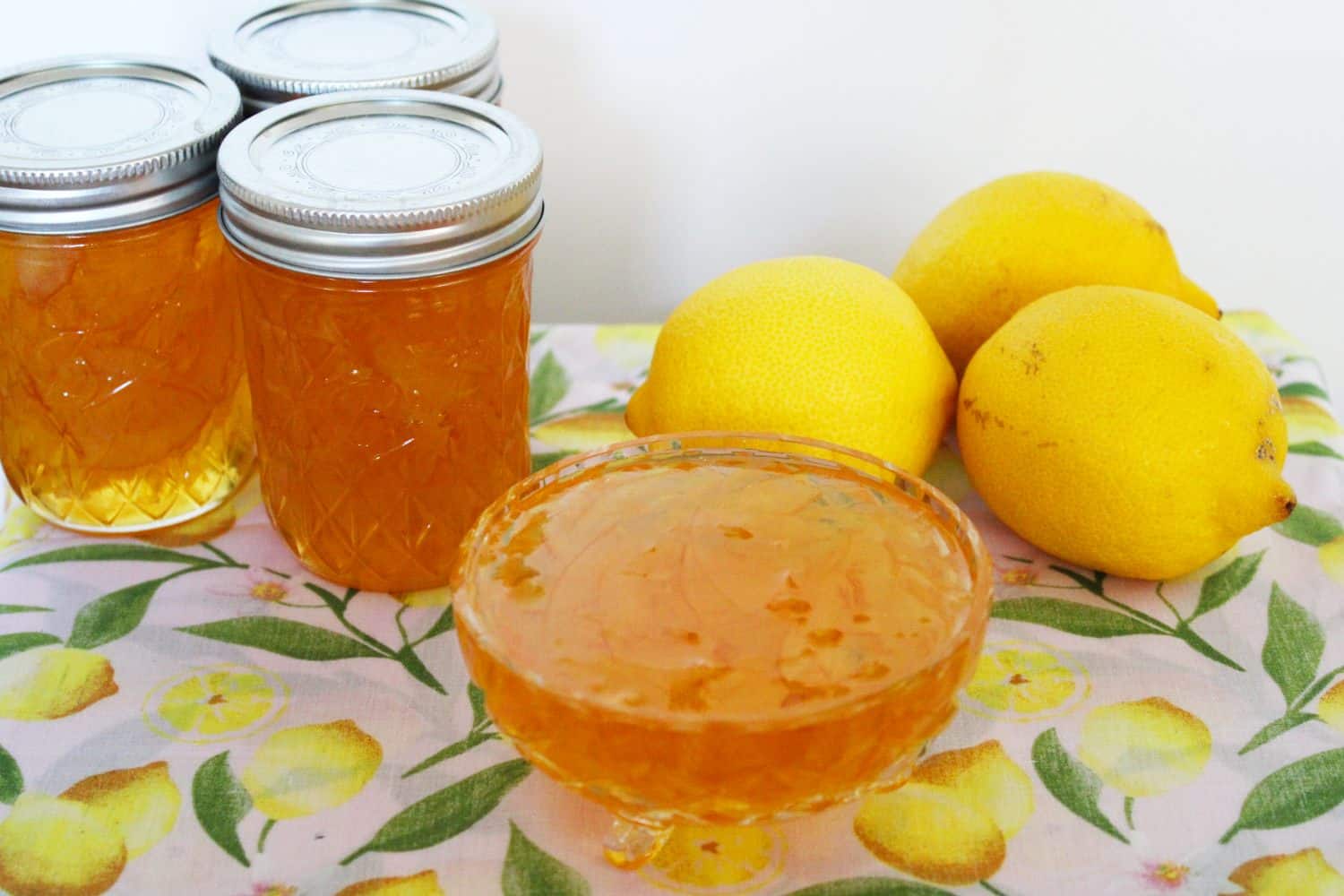
Tips for success:
You will not need any special equipment to make this recipe. However, a large saucepan is essential. When you add the sugar, it foams up enormously. Without a very large saucepan, there is the risk of it boiling over.
Your jars and their lids must be sterilised. I do this by heating them in the oven as outlined in the recipe.
As we are using the whole fruit, it is best to use organic or home-grown fruit. However, if you are only able to access commercially grown lemons, they need to be thoroughly cleaned.
Always use fruit which is in good condition and ideally some which are slightly under-ripe as they will contain more pectin. Bruised or damaged fruit may spoil the jam, causing it to deteriorate quickly.
It is important to cook the peel until it is tender before you add the sugar. Once you add the sugar the peel will no longer soften. After adding the sugar it is necessary to completely dissolve it before bringing the mixture back to the boil.
I find it best to check for setting point by checking a small amount of marmalade on a chilled plate. I use the “wrinkle” test, as detailed in the recipe. After reaching setting point, set the marmalade aside for 10 minutes to allow the fruit to settle.
Ladle the marmalade into hot jars to avoid the glass breaking.
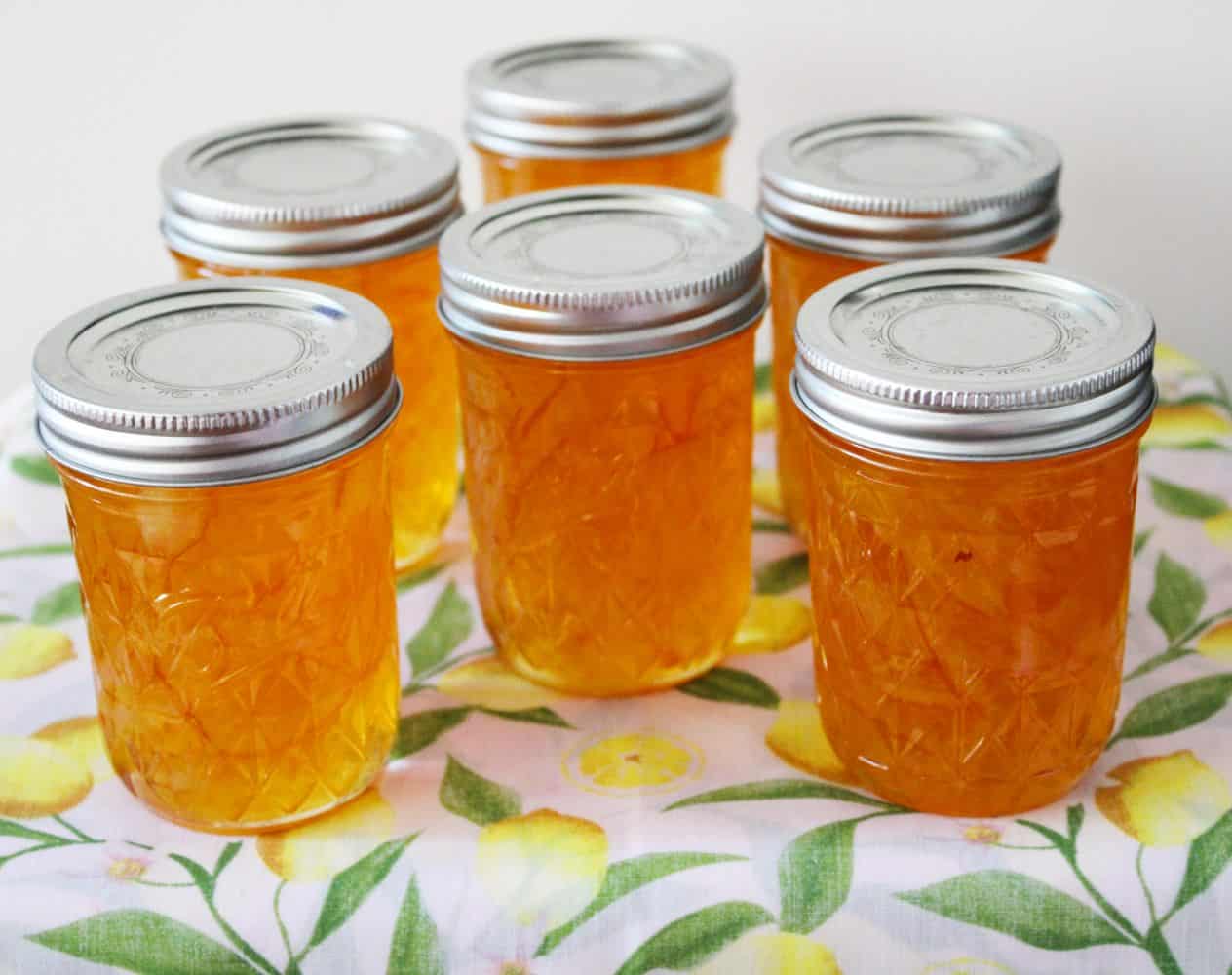
Other uses for these ingredients:
We love lemons, and some of our other favourite ways to use them are:
- Individual Lemon Curd Meringues
- Classic Lemon Curd
- Gluten-Free Lemon Madeleines
- Belgian Lemon Tea Cake
- Quick and Easy Lemon Ice Cream
More delicious condiments and edible gift ideas:
- Apricot Jam
- Fresh Peach Chutney
- Easy Plum Jam
- Classic Lemon Curd
- Dill Pickled Cucumbers
- Sweet Chilli Sauce
- Balsamic Glaze
- Preserved Chillies in Oil
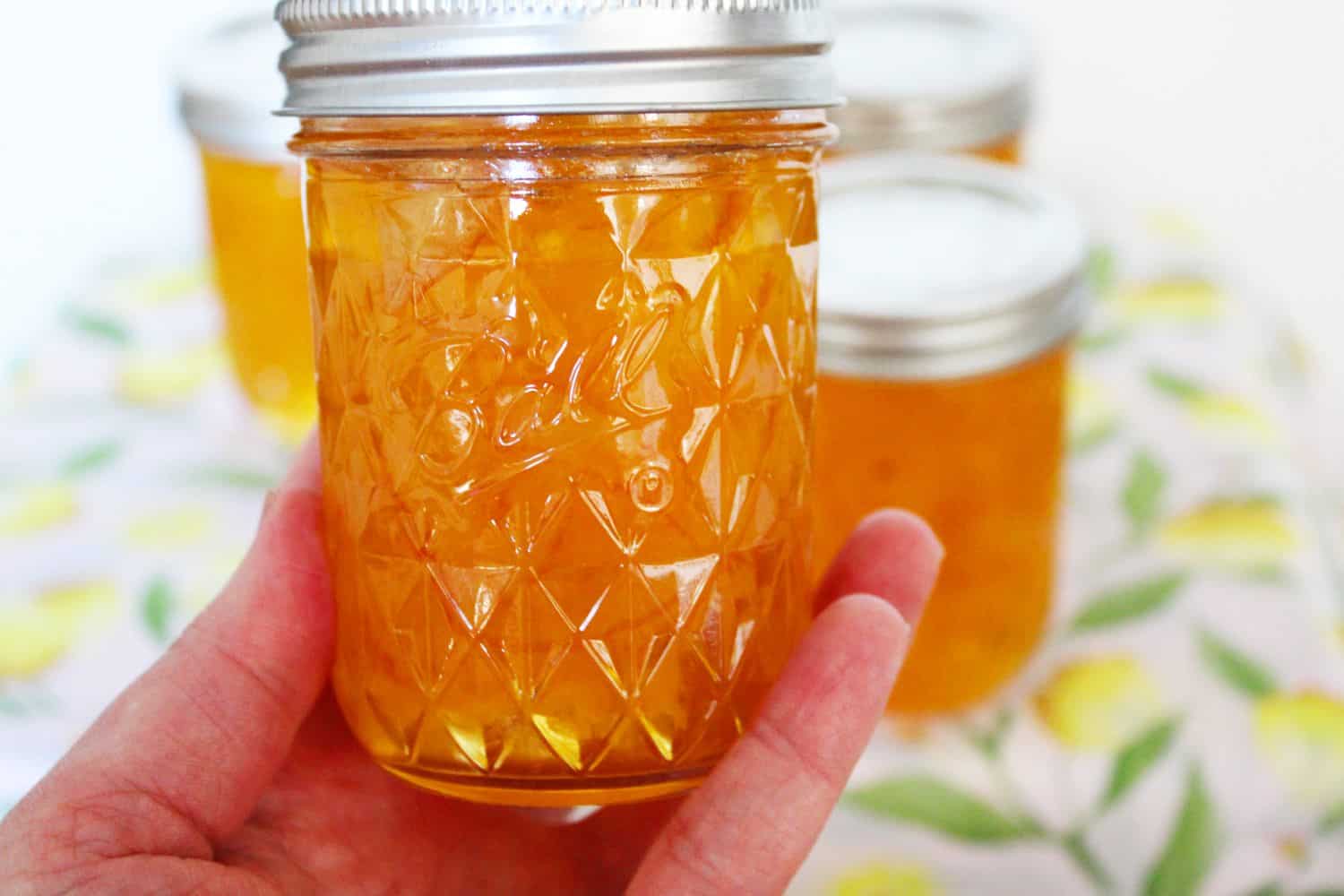
When it comes to using the Lemon Marmalade:
First and foremost, this bright and zesty condiment with the zingy flavour of lemon is a great wake-up call, perfect when slathered on your morning toast.
However, there are other ways in which to use it:
- A sticky glaze for chicken drumsticks;
- Make a sauce for pork tenderloin;
- Glaze a Christmas ham;
- Make crostini with goat cheese and prosciutto;
- Bake a lemon cake and make a glaze with the marmalade;
- Serve with Coconut Scones by A Baking Journey.
This refreshing condiment highlights the bright, tangy flavours of lemon. Although it is an ideal toast topping there are other ways in which to enjoy this condiment.
When you try it you will realise that there is no comparison between homemade marmalade and the commercially produced varieties.
Do let me know in the comments below when you have tried this delicious recipe.
Alex xx
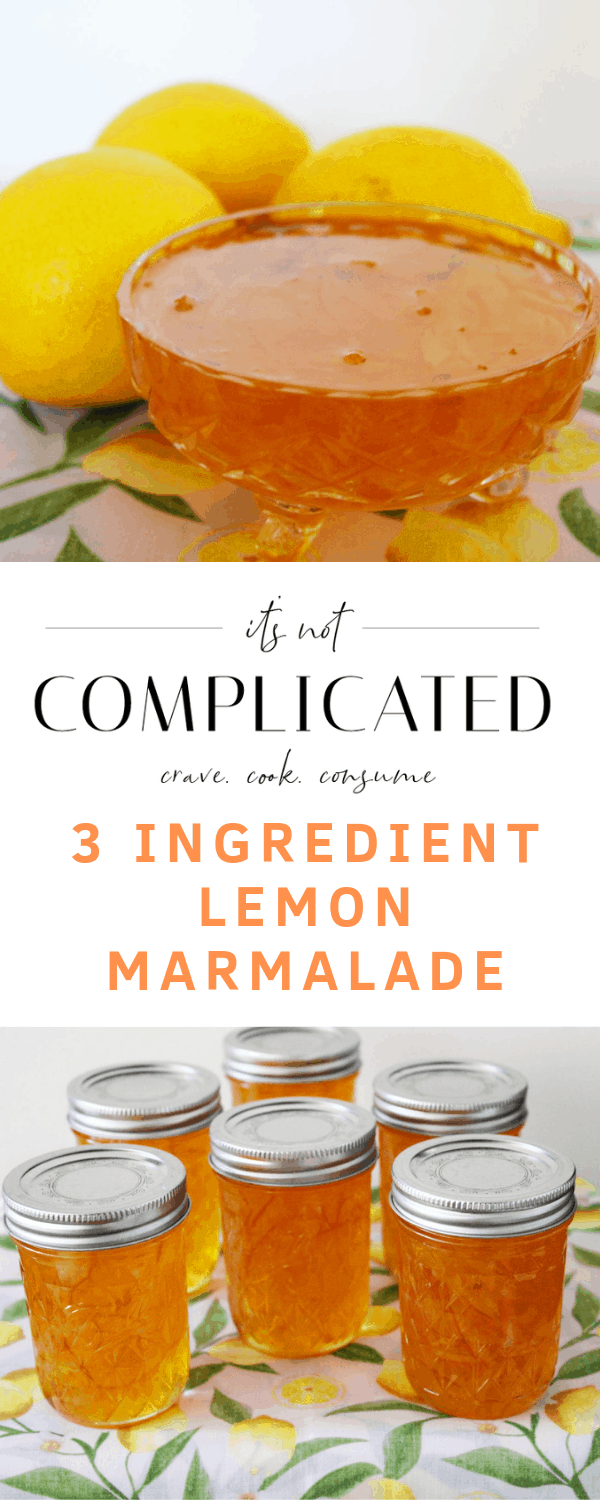
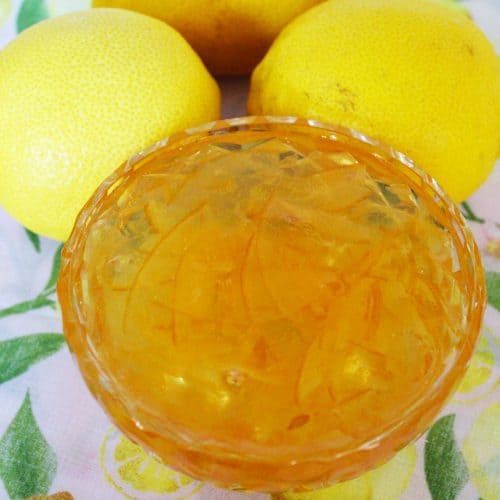
Three Ingredient Lemon Marmalade
Equipment
- 9 x 250ml Jars
Please note:
For accuracy, when weights are provided, we recommend weighing your ingredients. This will produce the best results. All oven temperatures listed are for fan forced.
Ingredients
- 500 g (17.5 ounces) lemons See Notes 1 & 2
- 6 cups (1.5 litre) water
- 8 cups (1.8kg) sugar
Instructions
Please Read First:
- Preserve making is quite simple, but we do recommend reading the recipe through first and following these tips:– weigh your ingredients for accuracy.– do not double the recipe or alter the quantities.– yes, it’s a lot of sugar. It’s also a lot of water. When making marmalade, the sugar is not just a sweetener, it also assists with gelling and preservation. When prepared properly, your end result will be the perfect mix of sweet, citrus tang and bitter, as marmalade should be. This is an old-fashioned recipe (my great great grandmothers.) – use a very large saucepan as the marmalade needs to rapidly boil and will foam up and you don’t want it to overflow.– ensure the marmalade reaches setting point. Keep in mind the marmalade will be very liquid while hot. Do not over boil as you will risk burning the marmalade.– allow 24-48 hours once jarred for the pectin to activate and the marmalade to set properly.– if after this time your marmalade hasn’t set, it likely wasn’t cooked for long enough initially. In this case, add the marmalade back to a clean saucepan with the juice of a fresh lemon. Bring back to the boil and start testing after 5 minutes of rapid boiling.
To sterilise the jars:
- Preheat the oven to 130 Degrees C (270F).Use glass jars with an airtight, metal lid. Wash them either in the dishwasher or by hand in hot soapy water, and rinse well. Check that the metal lids do not have rubber inserts. If they do, allow them to air dry.(See Note 9)
- Place upright jars and lids on a baking tray. Heat in the oven for at least 20 minutes, then remove and immediately fill with marmalade.
For the Lemon Marmalade:
- Place 2 saucers or small plates in the freezer, ready to check for the setting point of your marmalade.
- Thoroughly wash the lemons. Remove each end of the lemons and cut the lemons into quarters lengthways. Holding two of the quarters together, slice as thinly as possible and remove any seeds.
- Place the lemon slices in a non-reactive bowl. See Note 3. Add 6 cups of water, cover the bowl and leave the lemons to stand overnight.
- The following day, place the lemons and water into a large, non-reactive saucepan. – See Note 4.
- Over medium-high heat, bring the fruit and water to the boil. Boil for approximately 15 minutes or until the lemon peel is tender, stirring occasionally with a long-handled wooden spoon. – See Note 5. The time may vary slightly depending on the variety of lemon and the thickness of the slices.
- Add the sugar and stir well to dissolve it. After dissolving the sugar, return the fruit to the boil, stir occasionally and skim to remove any foam. Continue to stir until the marmalade reaches setting point, about 20 minutes. – See Note 6Remove from the heat to conduct the wrinkle test. If not set, continue to boil for another 1 minute and then test again.
- To test for setting point, I use the “wrinkle” test. Take one of your saucers from the freezer and pour a small amount of marmalade onto it. Let it cool for a minute then push against the marmalade with the tip of your finger. If the surface wrinkles it means setting point has been reached. Alternatively, if you are not confident checking this way or are not experienced at making marmalade, you can use the fail-safe method of using a jam/candy thermometer which you clip to the side of your saucepan. When attaching your thermometer, make sure that the base is not touching the bottom of the saucepan. Your marmalade has reached setting point when the temperature reaches 104.5 degree C or 220 degrees F. It will still be liquid at this point, and will set as it cools.
- Take the mixture off the heat and let the marmalade stand for about 10 minutes. This will help evenly distribute the fruit throughout the jars.
- Remove your jars from the oven and carefully ladle the marmalade into the heated, sterilised jars. You need to be very careful. Splashing yourself with hot marmalade will result in a very serious burn. I suggest you have clothing with long sleeves and ensure that you do not have children nearby. Put lids on jars immediately, and seal well – being careful to use a cloth or oven gloves to handle the jars/lids.
Video
Notes
- The weight of the lemons, before trimming the ends and removing the seeds, was 530 gm/1.2 lbs. We use Eureka or Lisbon lemons for this recipe.
- As the peel is such an important part of the marmalade, I like to use organic or home-grown lemons. Commercially produced lemons generally have a wax coating and may have been sprayed. If this is all that you can obtain, you can clean the lemons by placing them in a colander and pouring over freshly boiled water. Then, scrub them gently with a nail brush while holding them under cold running water.
- Non-reactive bowls and saucepans are stainless steel, glass, ceramic or enamelled cookware. Aluminium, copper and iron bowls or pans are reactive. Acidic foods, such as lemons, may discolour and take on a metallic taste if these are used.
- A large saucepan is essential. When you add the sugar, it foams up enormously. Without a very large saucepan, there is the risk of it boiling over.
- To stir, use a long-handled wooden spoon. Metal will become dangerously hot.
- Boiling time depends on several factors, the width of your saucepan and the heat at which the fruit is boiled.
- The Marmalade will be shelf stable for approximately 12 months.
- Your marmalade will be very liquid when you add it to the jars so please don’t be concerned. It will continue to thicken as it cools. Leave it for 24-48 hours and then check again. If it is still runny, you can re-boil the marmalade. Empty the contents of the jars back into the saucepan and bring to a boil. To increase the pectin and help the marmalade to set, you can add the juice of half a lemon. Boil for a few minutes and test again.However, if the marmalade was initially boiled too long, it can still result in it not setting as the pectin may have been damaged.
- Properly sterilising your jars is an essential process to remove bacteria which could cause your preserves to spoil. I prefer to sterilise jars in the oven. To do this, preheat your oven to 130 Degrees C (270F). Use glass jars with an airtight, metal lid. If recycling jars, ensure that the jars do not have cracks or chips and the lids are in good condition. Discard any lids that are pitted or rusted. Wash the jars and lids either in the dishwasher or by hand in hot soapy water, and rinse well. Do not dry them with a tea towel. Place upright jars and lids on a baking tray. If you are using kilner jars with rubber seals, be sure to remove the seals before placing the jars in the oven. The dry heat of the oven would damage the seals. Boil the seals separately in a saucepan for about 10 minutes. Heat the jars in the oven for at least 20 minutes. When your preserves are ready to bottle, use thick oven mits or jar tongs to remove the jars. Do not place them on a cold surface as they may shatter. I place mine on a wooden chopping board which I cover with a tea towel. Always sterilise a few more jars than you think you will need. It is better to have too many jars than not enough.
- Please note, the nutritional information is based on one 250ml jar. Please take this into account, as you most likely won’t be consuming a whole jar in one sitting. The nutritional information is an estimate only.
Nutrition Estimate:
Nutritional Disclaimer:
The nutritional information is an estimate only, and is derived from online calculators. For accurate results, we recommend calculating the nutritional information based on the ingredients and brands you use.

Addie
I love how easy this recipe is! So quick to prepare and tastes amazing!
Alexandra
Hi Addie, I am so happy to hear that you enjoy the Lemon Marmalade. Thank you for taking the time to let me know. 🙂
Maggie Smith
So, not sure if I have read the recipe right, I made it, using 500g of lemons to 1.8kg white glandular sugar, mine came out very runny, I boiled it to setting temp of 104.5 degrees C. It tastes good. Will try again.
Alexandra
Hi Maggie,
That is correct 🙂 It is a soft set Marmalade – if you have a look at the recipe in the video card, you can get an idea of the texture. Commercial varieties will be a lot thicker.
Did you happen to try the wrinkle test on the cold plate also? Just to make sure that the thermometer is accurate 🙂
Please feel free to reach out with any questions! Kind regards, Alex
Bernice
Wow! When life gives you lemons….make marmalade! This lemon marmalade is kind of a ‘entry level’ marmalade because it’s not quite Seville. I much prefer this milder version.
Alexandra
Hi Bernice, thank you for your feedback on the Lemon Marmalade. I am delighted that you enjoy it. 🙂
Patricia
I’ve come into a LOT of lemons recently. Have you tried doubling (or even tripling) this recipe? Thanks!
Alexandra
Hi Patricia!
In general, we don’t recommend doubling or tripling the recipe. This is for a couple of reasons – it would take longer to boil, and the flavour wouldn’t be as vibrant, but also, this makes a large quantity as is, and requires a large saucepan (as it cooks it can boil up significantly).
It may be worth doing it in a couple of batches in individual saucepans. This way you can ensure you get the perfect set on the marmalade and retain the best flavour.
Let me know if you try the recipe. Kind regards, Alex
Jacqui
Such a genius recipe! I love how simple yet flavorful it turns out.
Alexandra
Hi Jacqui, thank you for your comments on the Lemon Marmalade, I’m so pleased that you enjoyed it. 🙂
Ian Bell
Hello Alex! I’ve been given 1.72 kilos of perfect seedless limes, and 1.05 kilos of beautiful ripe unsprayed organic lemons! Would it be too much to cook them all at once? I’m a male, for whom the kitchen is a foreign country so I don’t want to make repeated batches to use up the fruit before it goes off, but lemon/lime marmalade is a GREAT favoutite and your recipe is SO tempting! If I use larger quantities, I guess I must double up on the sugar? And can I use brown sugar? Grateful for your reply!
Ian
Alexandra
Hello Ian,
Thanks so much for your question!
Unfortunately, that is not something I would recommend. With our recipe, a large saucepan is required – a bigger batch would need something absolutely enormous as the liquid does boil up vigourously.
Also, a larger batch will require a longer cooking time, and we have found this can dull the flavour slightly – the less time it needs to cook for, the more vibrant the flavour will be.
If you were to do a larger batch, yes, the sugar would need to be doubled etc. (Reducing the sugar can reduce the setting of the marmalade as well as how long it will keep for.)
I have not tried brown sugar, however, have had readers do this with success.
My recommendation would be to do a batch at a time – or if you have a couple of large saucepans, you could stagger a couple of batches – this will allow you to check for the setting point without taking the cooking too far.
I hope you’ll enjoy the marmalade!
Many thanks, Alex
Amanda
Hi Alex!
I made your delicious lemon recipe, and also the orange version which I saw you were kind enough to leave in the comments.
I also just left you a comment on the plum jam. Your recipes are always so simple and delicious – thanks!
Alexandra
Hi Amanda, thank you so much for your lovely comments. I am so happy to hear that you made two Marmalades as well as the Plum Jam. I do appreciate that you took the time to provide feedback. 🙂
Agneta
Hi Alexandra! I like you lemon marmalade recipe and the ‘simplicity’ of it. However, I do not have a saucepan large enough for the quantities you are indicating. Would you be kind enough to tell me roughly your saucepan is, please.
Alexandra
Hi Agneta, the saucepan that we use is a heavy bottom stainless steel 8-litre size.
Hope that helps! Kind regards, Alex
Denise
It’s awesome and so easy to make this is the first time I have ever made marmalade jam this is the forth time I have made it, thank you so much for a great recipes 🙏💜🕉💯🥰Denise
Alexandra
Hi Denise 🙂 Thank you so much. I am so happy you are enjoying the recipes!
Kind regards, Alex
Jane J
Hi, I’m excited to try this recipe! I usually do a water bath after canning my jams and jellies and was wondering if it’s not necessary for this marmalade for it to still be shelf stable?
Alexandra
Hi Jane,
You certainly can process it in a water bath if you prefer.
That being said, this recipe will be shelf-stable for 12 months if you follow our instructions.
Let me know if you give the marmalade a try!
Kind regards, Alex
Tracy
This recipe was easy to make. I bought a thermometer as wanted to ensure it would set. The recipe made 10 x 250ml jars for me. Yummy flavour. Will definitely only use this recipe now. Thanks!
Alexandra
Hi Tracy, thank you for your lovely comments on the Lemon Marmalade. I am so happy to hear how much you enjoy it and appreciate that you took the time to let me know. 🙂
Robyn Blacket
Hi, I’ve just cut up the lemons ready to make this marmalade. However, when I started reading other recipes, I discovered that many were suggesting not to include the pith in the jam. They said it made the jam bitter. What do you suggest?
Alexandra
Hi Robyn,
Thanks for your question!
That is why we include the step of soaking the lemons as it does mellow the flavour. The pith is an important part, as it contains high levels of pectin, and is necessary to set the marmalade. Our recipe uses a higher quantity of water than many to counteract the bitterness. Because we use the pith, the cooking time is faster and that will give you a more fresh, vibrant flavour of marmalade. It should be the perfect balance of tangy lemon, a slight bitter edge that is present in marmalade, and the perfect amount of sweetness.
Hope that helps, and let me know if you have any further queries! I hope you enjoy our family recipe.
Kind regards
Alex
Sara Marie
Followed recipe as written and is absolutely perfect.
Alexandra
Hi Sara Marie, I am so pleased that you enjoyed the Lemon Marmalade, thank you for letting me know. 🙂
Anita
What a super recipe! Very easy and super delicious!
I made it using a mix of lemons and limes and was wondering if it would be just as successful using oranges?
Thanks in advance,
Anita
Alexandra
Hi Anita!
Thanks so much for your comment – so pleased you enjoyed the marmalade, and lemon and lime is a delicious combination!
We haven’t published our Orange Marmalade recipe yet, but here’s what we do.
Ingredients:
500 g orange (after trimming) – I used Navel oranges
6 cups water
60 ml lemon juice
1 kg granulated sugar
Method:
Trim off the thick, pithy ends of the oranges.
Cut in quarters, remove the central pith, slice the orange as thinly as possible.
Add the fruit and water to a large bowl and soak overnight.
Add orange, soaking water and lemon juice to a large, wide saucepan.
Over med-high heat, bring to a boil and boil until the fruit is cooked and feels tender, about 15 minutes.
Lower the heat and add the sugar. Stir occasionally until the sugar completely dissolves.
The jam froths up a great deal.
Increase the heat and stir occasionally until the jam reaches setting point. This took about 30 minutes but will vary depending on the size of the saucepan and the amount of heat.
When setting point is reached, set the jam aside for about 10 minutes. Ladle into hot, sterilised jars.
It made 6 x 260 ml jars.
Please refer to the Lemon Marmalade for information on sterilising jars and other helpful tips, etc.
I hope this helps.
Kind regards, Alex
Anita
Oh wow! That’s fantastic! Thank you so, so much!
I will definitely let you know how it turns out!
Anita
Denise
Love this recipe
Alexandra
Hi Denise, I’m so happy to hear that, thank you for taking the time to let me know. 🙂
MaryAnne
Great recipe! I doubled the number of lemons,though, because I like a really chunky marmalade. Great hint about leaving the mixture for 10 mins to help with distribution of peel!
Alexandra
Hi MaryAnne, thank you so much for your feedback on the Three Ingredient Lemon Marmalade. I am so pleased that you enjoy it. 🙂
Ruth Stice
I made this ; I love how simple it is to make delicious lemon marmalade! Thank you for sharing the recipe. I I only had a few jars, so I made half a recipe, but it came out beautifully.
Alexandra
Hi Ruth, I am so happy to hear that you enjoy the Lemon Marmalade; there is nothing quite like homemade. Thank you for taking the time to let me know. 🙂
Andrea
Wonderful, easy to follow recipe.
Alexandra
Hi Andrea, I am so pleased that you enjoy our Lemon Marmalade and appreciate that you took the time to let me know. 🙂
Batya
I’m using your recipe . Right now they are soaking overnight. But I’m using mini lemons from my neighbors tree. Similar in size to kumquats. They don’t have much pith on them . So I’m debating if I need all the sugar. What do you think?
Alexandra
Hello Batya, yes, I would recommend that you use all the sugar. It has an important role in helping the marmalade reach setting point and in keeping it shelf-stable. I hope you enjoy it. 🙂